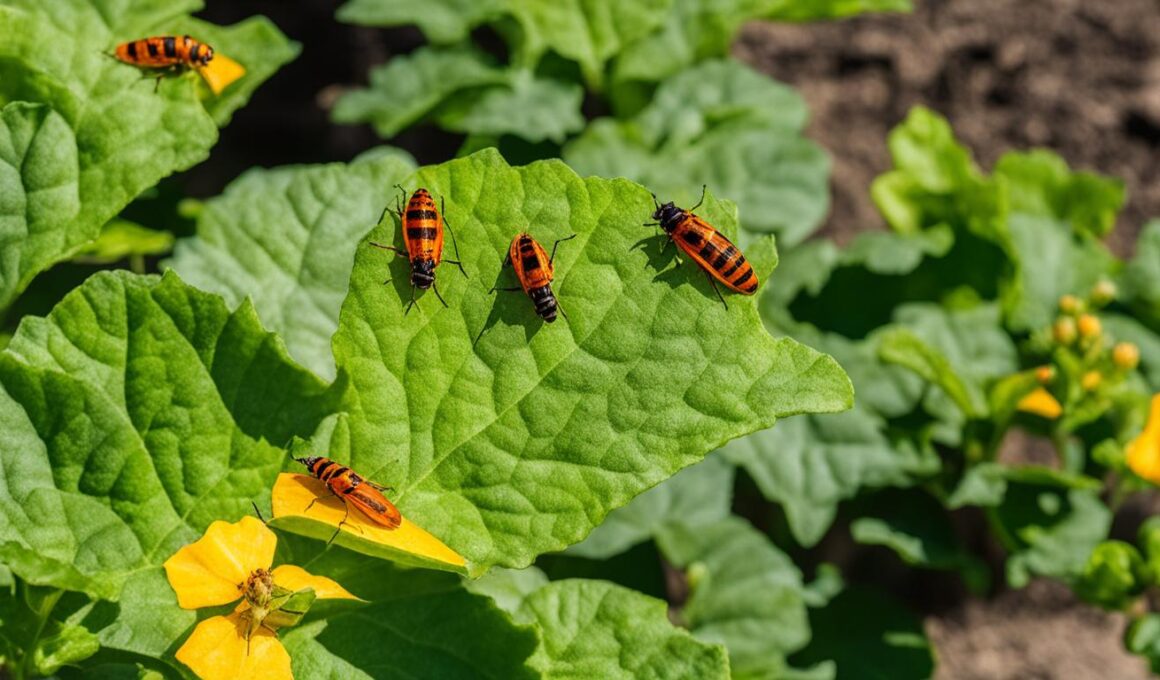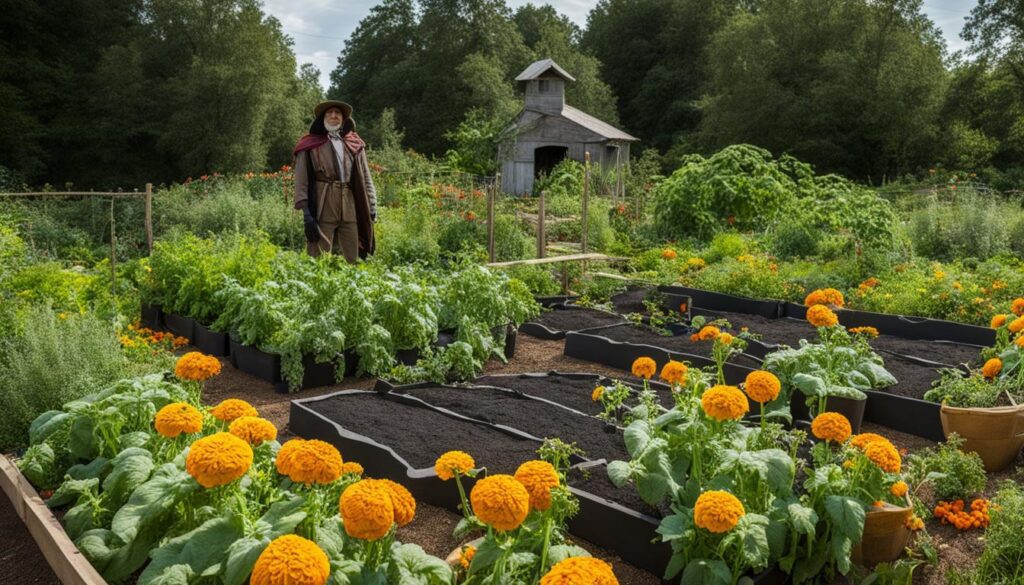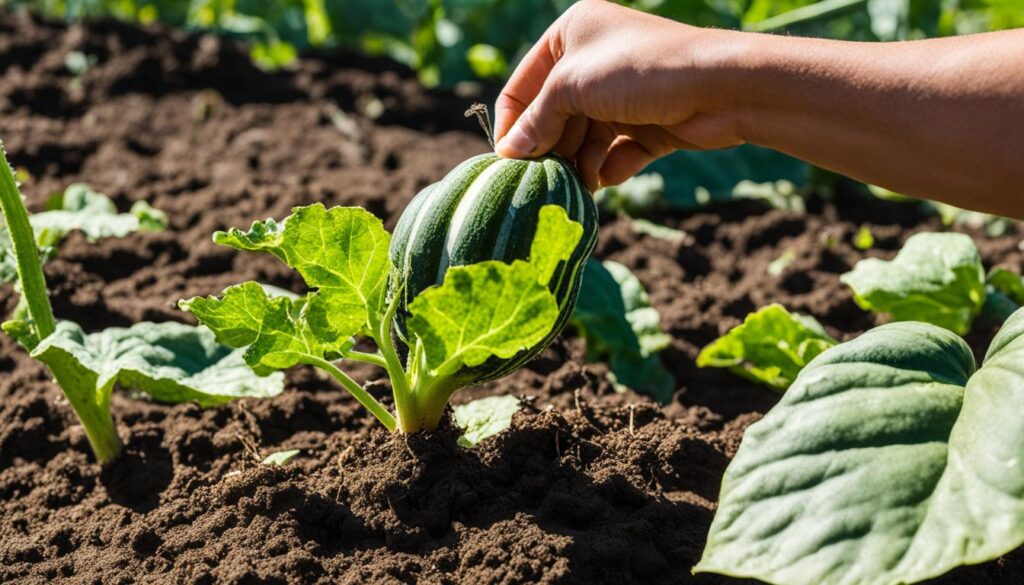Are you tired of battling garden pests that threaten to destroy your precious squash plants? Look no further! In this article, we will guide you through effective methods and organic solutions to defeat the notorious squash vine borer. By implementing our expert strategies, you can protect your garden and enjoy a bountiful harvest of healthy squash.
Key Takeaways:
- Identify squash vine borers through wilting plants, stem holes, and frass presence near openings.
- Prevent squash vine borers by starting plants early, using physical barriers, and practicing succession planting.
- Remove squash vine borers manually, utilize insecticides, and trap adult moths for effective control.
- Expert tips include using wood ashes, diatomaceous earth, and catching and destroying moths.
- Implement prevention strategies to reduce the risk of squash vine borer infestation.
What are Squash Vine Borers?
Squash vine borers are a destructive pest that can wreak havoc on your squash plants. These pests are actually the larvae of the sesiid moth, which lay their eggs on squash plants. Once the eggs hatch, the larvae bore into the stems of the plants, slowly eating away at them and causing significant damage.
Adult squash vine borer moths can lay up to 150 eggs in a single season, which means that if left unchecked, these pests can quickly multiply and destroy your entire crop. The borers tunnel through the stems, cutting off the flow of nutrients and water to the plants, resulting in wilting and eventual death.
Identifying squash vine borers is important in order to take appropriate action. The adult moths are about ½ to ¾ inch long and have distinct clear wings with black and orange markings. The larvae are creamy white with a brown head and can be found inside the stems of squash plants. Keep an eye out for frass, a sawdust-like substance, near the holes in the stems, as this is a sign of squash vine borer activity.
Table: Squash Vine Borer Description
| Common Name | Squash Vine Borer |
|---|---|
| Scientific Name | Melittia cucurbitae |
| Life Cycle | Egg → Larva → Pupa → Adult |
| Host Plants | Squash, pumpkins, zucchini, and other cucurbit plants |
| Damage | Wilting, holes in stems, frass near openings |
| Control | Prevention strategies, manual removal, insecticidal treatment |
Now that you know what squash vine borers are and how to identify them, it’s time to explore effective prevention strategies to protect your squash plants from these destructive pests.
Identifying Squash Vine Borer Damage
Squash vine borer damage can wreak havoc on your precious squash plants, causing them to wilt and ultimately leading to their demise. Understanding how to identify the signs of squash vine borer damage is crucial in order to take immediate action and save your plants.
One of the tell-tale signs that your squash plants are being affected by vine borers is sudden wilting. If you notice your plants looking limp or droopy, it could be a result of the borers feeding on the stems. Another indicator is the presence of holes in the stems. These small entry points are where the larvae enter and start their destructive feeding process. Additionally, you may spot frass, which is the waste material left behind by the borers, near the openings. The presence of frass confirms the presence of squash vine borers.
Signs of Squash Vine Borer Damage:
- Wilted squash plants
- Holes in the stems
- Presence of frass near the openings
Once the damage has been done, it is unlikely that the affected squash plant will recover. Therefore, early detection and identification of squash vine borer damage is crucial to prevent further destruction.
Now that you can recognize the signs of squash vine borer damage, it’s time to move on to prevention strategies in the next section.
Prevention Strategies for Squash Vine Borers
Preventing squash vine borers is essential for protecting your squash plants and ensuring a bountiful harvest. By implementing organic methods and physical barriers, you can effectively prevent squash vine borer infestations. Here are some proven prevention strategies:
- Start squash plants early: Begin seedlings indoors and transplant them into the garden once the threat of frost has passed. This helps establish healthy plants that are less vulnerable to squash vine borers.
- Avoid consecutive squash plantings: Do not plant squash in the same area two years in a row. Squash vine borer eggs may remain in the soil, and by rotating your crops, you reduce the risk of reinfestation.
- Use physical barriers: Create a physical barrier around your squash plants to prevent squash vine borer moths from laying their eggs. Nylon stockings or row covers can be used to cover the plants, making it difficult for the moths to access them.
- Plant resistant varieties: Choose squash varieties that have natural resistance to vine borers. These varieties are less attractive to the pests and are more likely to withstand an infestation without severe damage. Check with your local garden center or agricultural extension for recommended resistant varieties.
- Practice succession planting: Rather than planting all your squash at once, stagger your plantings throughout the season. This ensures a continuous supply of squash and reduces the impact if some plants become infested with squash vine borers.
By implementing these prevention strategies, you can create a less favorable environment for squash vine borers and minimize the risk of infestation. Remember to regularly monitor your plants for signs of damage and take immediate action if squash vine borers are detected.
Table: Recommended Squash Varieties for Vine Borer Resistance
| Variety | Resistance | Maturity |
|---|---|---|
| Butternut | High | 80-110 days |
| Acorn | Moderate | 80-100 days |
| Delicata | Moderate | 90-100 days |
| Spaghetti | Low | 80-100 days |
Table: Recommended resistant squash varieties for preventing squash vine borer infestations. These varieties have shown varying degrees of resistance to squash vine borers and can be a valuable addition to your garden.
Effective Methods to Get Rid of Squash Vine Borers
If your squash plants have already fallen victim to squash vine borers, don’t despair. There are several effective methods you can use to combat these destructive pests.
1. Manual Removal: One of the most straightforward methods is manually removing the borers from the affected plants. To do this, carefully slit the stems using a sharp knife and remove the borers by hand. This method can be time-consuming but can significantly reduce the population of squash vine borers in your garden.
2. Use of Insecticides: Insecticides can be an effective tool in controlling squash vine borers. One commonly used insecticide is Bacillus thuringiensis (Bt), a natural bacteria that specifically targets and kills certain caterpillars, including squash vine borers. Be sure to carefully follow the instructions on the product label when applying insecticides.
3. Trapping Moths: Trapping adult squash vine borer moths can help reduce their population and prevent future infestations. You can create traps using yellow sticky cards or pheromone traps specifically designed to attract and catch the moths. By removing the adult moths from your garden, you can disrupt their breeding cycle and prevent further damage.
It’s important to remember that these methods are most effective when used alongside prevention strategies, such as planting resistant varieties and implementing physical barriers. By combining these approaches, you can increase your chances of successfully controlling squash vine borers and protecting your squash plants.
Table: Comparison of Squash Vine Borer Control Methods
| Control Method | Pros | Cons |
|---|---|---|
| Manual Removal | – Effective in reducing borer population – Organic method |
– Time-consuming – Requires regular inspections |
| Use of Insecticides | – Can quickly kill borers – Provides targeted control |
– Chemical-based – Follow safety precautions |
| Trapping Moths | – Disrupts breeding cycle – Prevents further infestations |
– Requires monitoring and maintenance – May not eliminate all borers |
Table Summary: A comparison of different methods for controlling squash vine borers, including manual removal, use of insecticides, and trapping moths. Each method has its pros and cons, and using a combination of these approaches can increase the effectiveness of squash vine borer control.
Expert Tips for Squash Vine Borer Control
When it comes to controlling squash vine borers and protecting your beloved squash plants, the experts have a few tricks up their sleeves. These expert tips can help you effectively combat these destructive pests and ensure a thriving garden. Here are some tried and tested methods:
1. Wood Ashes as a Natural Deterrent
Wood ashes can act as a natural deterrent for squash vine borers. Sprinkling a thin layer of wood ashes around the stalks of your squash plants can discourage the moths from laying their eggs and prevent the borers from infesting your plants. The alkaline nature of wood ashes creates an environment that makes it less appealing for squash vine borers to attack.
2. Diatomaceous Earth for Mechanical Defense
Diatomaceous earth, a fine powder made from the fossilized remains of marine algae, can be an effective mechanical defense against squash vine borers. Sprinkle a thin layer of diatomaceous earth around the base of your squash plants, focusing on the stems. This natural powder works by physically dehydrating and lacerating the soft bodies of the larvae, preventing them from burrowing into the stems.
3. Catching and Destroying Adult Moths
Another expert tip for squash vine borer control is to catch and destroy the adult moths. Adult moths are attracted to certain colors, particularly yellow and white. You can create simple traps using yellow sticky cards or white fabric coated in sticky substances. Place these traps near your squash plants to catch the adult moths and prevent them from laying eggs.
By utilizing these expert tips, you can take proactive measures to control squash vine borers and protect your precious squash plants from their destructive presence.
Can the Same Methods Used to Get Rid of Snails in the Garden Also Work for Squash Vine Borers?
Yes, the same methods used for getting rid of snails in the garden can be effective for squash vine borers. Natural remedies like diatomaceous earth, handpicking, and attracting beneficial predators can help control both pests. Additionally, using row covers and planting resistant varieties can also deter squash vine borers.
Conclusion
In conclusion, effectively controlling squash vine borers is crucial for protecting your squash plants from their destructive damage. By implementing a combination of prevention strategies and targeted control methods, you can successfully manage these common garden pests.
First and foremost, prevention is key. Utilize physical barriers like nylon stockings or row covers to create a barrier between the adult moths and your squash plants. Additionally, practicing succession planting and avoiding planting squash in the same area for consecutive years can disrupt the squash vine borer’s life cycle.
If your plants do become infested, prompt action is essential. Manual removal, by slitting the stems and removing the borers by hand, can be an effective method. Consider using insecticides like Bacillus thuringiensis (Bt) to target the larvae. Additionally, trapping and destroying adult moths can help reduce the population of squash vine borers in your garden.
In conclusion, maintaining an integrated approach that combines prevention, targeted control, and expert advice is the most effective way to control squash vine borers and safeguard your squash plants. By implementing these strategies, you can enjoy a bountiful harvest while minimizing the damage caused by these destructive pests.
FAQ
How can I prevent squash vine borer infestation?
Some effective prevention strategies include starting squash plants early, avoiding planting squash in the same area two years in a row, using physical barriers such as nylon stockings or row covers, and planting varieties of squash that are resistant to vine borers.
How can I identify squash vine borer damage?
Squash vine borer damage can be identified by sudden wilting of squash plants, holes in the stems, and the presence of frass (chewed up stem material) near the openings.
What should I do if my squash plants are already infested with squash vine borers?
If squash vine borers have already infested your plants, you can try manually removing the borers by slitting the stems and removing them by hand. Other methods for getting rid of squash vine borers include using insecticides, such as Bacillus thuringiensis (Bt), and trapping the adult moths.
Are there any additional tips for controlling squash vine borers?
Experts recommend using wood ashes as a natural deterrent, sprinkling diatomaceous earth around the stalks of squash plants, and catching and destroying the moths to help control the population of squash vine borers in your garden.











